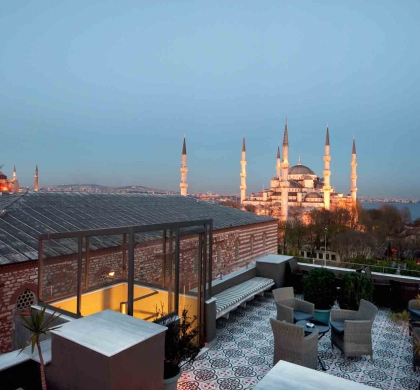Buy or gift a stand-alone digital subscription and get unlimited access to dozens of back issues for just £18.99 / $18.99 a year.
Please register at www.exacteditions.com/digital/cornucopia with your subscriber account number or contact subscriptions@cornucopia.net
Buy a digital subscription Go to the Digital EditionThree centuries ago Cornelius Loos, Charles XII’s military draughtsman, captured the atmospheric grandeur of Ayasofya’s interiors with panache and precision. Robert Ousterhout lingers over Loos’s peerless drawings
Details, details, details… What a treat it is to see the surviving drawings and watercolours of Cornelius Loos reproduced full-scale (or close to it) and in colour! And what a pity that only one-fifth of the 250 images he executed during his travels in the Ottoman Empire (1710–11) survive. The others were destroyed in 1713, in a fire in King Charles XII of Sweden’s camp in Bender (now in Moldova) during the kalabalık riot. The surviving 50 drawings, which had been kept under the King’s bed, returned with him to Sweden the following year.
The adventures of Charles and his entourage are certainly worth a good romantic novel or possibly a movie. A few Swedish and Russian films have focused on the Great Northern War, which dragged on from 1700 to 1721, and the fateful Battle of Poltava (1709), but what transpired as Charles and his army fled south into Ottoman territory is just as fascinating. Charles’s Ottoman escapade, during which he was effectively held under house arrest by the Sultan, ruined a promising career and left Sweden with a humiliating debt.
I first encountered Charles in 1987, when I excavated a Byzantine church in Didymoteichos (Dimetoka in Greek Thrace, where Charles was held briefly in 1714, after the disaster at Bender) next to the so-called Filakes Karolou, the “Prison of Charles”, a misnamed rock-cut storeroom that remains far more popular locally than my excavation. Charles certainly was provided with more exalted accommodation. The local football team – one of whose members dug with me – wore the colours of Sweden in his memory. But that’s another story. Loos’s drawings are far more interesting than my salad days as an archaeologist.
In early 1710 Charles dispatched three young officers to travel to Istanbul and elsewhere in the Ottoman Empire, “to take into sight the existing rarities and monuments there, to draw and to measure”. Among them was Cornelius Loos, a trained military draughtsman. As army personnel, their intentions went far beyond sightseeing, for Sweden was keenly interested in the military capabilities of the Ottomans. Nevertheless, Loos seems to have been easily distracted, and for this, we are forever in his debt.
The astrophotographer Tony Hallas spent an idyllic childhood in 1950s Turkey, where he first marvelled at the night sky. On his recent return, he found hulking cruise ships and Disneyfied destinations. Here, in the first of two articles, he looks back at the Turkey he left behind, and evocative family photographs capture a world waiting to be discovered
The artist Lithian Ricci has rescued a dilapidated old house on the Golden Horn – and transformed it into a magical work of art. Berrin Torolsan is dazzled. Photographs: Monica Fritz
A portrait coming up for sale at Sotheby’s in October is one of the finest portrayals of an Ottoman lady of the 16th century. Julian Raby peels away centuries of confusion to establish her true identity – as Süleyman’s wife, the legendary Roxelana
Defeated by Russia in 1709, Charles XII of Sweden took refuge with the Sultan. Confined to camp, the King sent out Cornelius Loos, his military draughtsman, to capture the wonders of the Ottoman Empire. Only 50 of the drawings Loos brought back survive – rescued from beneath the King’s bed during a riot. Philip Mansel dives into a splendid book on Loos’s eye-opening work, and Robert Ousterhout marvels at his drawings of Ayasofya
In 1833 Horace Vernet, the French Orientalist, created a fabulous ‘Turkish Room’ at the top of a tower in Rome’s Villa Medici. By Paolo Girardelli. Photographs: Daniele Molajoli
For many peoples bulgur came before bread. It may now be ultra-fashionable, but versatile, nutritious bulgur was in fact the world’s first processed food. Berrin Torolsan celebrates the revival of this Anatolian staple and its nutty joys with a collection of intriguing recipes
Ever since it was founded in 1945 on the edge of Istanbul, people have flocked to eat at Beyti’s, the grill house that taught the city the importance of Sunday lunch. The journey, says Andrew Finkel, is always worth the effort


Cornucopia works in partnership with the digital publishing platform Exact Editions to offer individual and institutional subscribers unlimited access to a searchable archive of fascinating back issues and every newly published issue. The digital edition of Cornucopia is available cross-platform on web, iOS and Android and offers a comprehensive search function, allowing the title’s cultural content to be delved into at the touch of a button.
Digital Subscription: £18.99 / $18.99 (1 year)
Subscribe now